After a summer spent overexposing bulk bought colour negative film on trips to the beach and praying that the airport scanners weren’t going to fry my film on the way home, I decided that I wanted to step up my game this autumn. It wasn’t flat pastel tones and dreamy sunsets that inspired me to pick up my camera again, but the gritty, dramatic, black and white images taken by photojournalists throughout the mid 20th century and the documentary/street style of photography that followed in its wake.
When I heard that last month’s Extinction Rebellion protests in Central London had extended beyond their authorised territory of Trafalgar Square and into the City of London, I knew that this was an opportunity that could not be missed. What follows is the story of my first foray into this hallowed style of photography.
Introduction
I usually find myself compelled to read the ‘5 frames with…’ articles here on 35mmc for one of two reasons. Firstly, because I am interested, inspired or otherwise moved by the subject of the photograph, either through the composition of the image, the lighting or the choice of subject; referred to from here on in as “the creative component.” Secondly, because I would like to emulate what the photographer has achieved with an emulsion, development process or any other physical manipulation of his or her equipment to achieve a specific ‘look’; “the technical component.”
I understand that this is an oversimplification of the photographic process, and that my chosen nomenclature might be misleading (I would never contradict anybody that suggest a good degree of creative vision is required when selecting a developer, dilution or agitation scheme for example), but for the purpose of this short written article I believe it to be the most efficient way to concisely articulate that which may be of interest to the reader.
The Creative Component
For me, as for many others I am sure, the difference between a ‘good’ and a ‘great’ Street Photograph is narrative. I want an image to take me on a journey, to tell me a complete story, from beginning to end. This is something that I notice in the work of photographers whom I admire, but have been unable to reproduce in my own images. A protest seemed to me to be the perfect place to try and hone this skill, the Extinction Rebellion narrative is well known and widely promulgated, surely all I had to do was turn up and click my shutter!
I know there are purists that will accuse me of confusing ‘Street’ and ‘Documentary’ styles, but I disagree. In this article I have elected to separate the photographic process into two categories because I believe it adds value to the discussion and allows me to structure and better formulate and express my own thoughts. The same is true to me of photographic genres; when used correctly categories like ‘Street” add value by identifying a style that appeals to a specific community or provides a cohesive theme for an exhibition, book or magazine. When such a term is used to impose rules on how a photograph may be taken or dictates the subject matter to the photographer I think it removes a degree of freedom from the person behind the camera and usually such limitations are more hindrance then help.
There have been some fantastic images created recently at the scene of these protests, many of which have been published in the national papers, other shared on social media and others more here on 35mmc. Simon King wrote a brilliant article discussing the merits of using a rangefinder or an SLR to capture the action and in doing so produced some truly memorable images. If you haven’t already, I would strongly advise reading his article; whilst the technical discussion is certainly interesting it is his accompanying images that really inspired me to get out on the streets of London on this rainy Monday afternoon.
As I, somewhat facetiously, mentioned earlier, the Extinction Rebellion narrative is widely known. The majority of press photos captured vast crowds of people marching up and down the streets as this perfectly illustrated the message that they were sending in their articles about mass civil upset and disruption. The images didn’t speak to me in the same way that Simon’s did, they seemed impersonal and it was often hard to pick a face out of the crowds. It was the banners that the people carried high above their head that told their story, not the body language or the emotion of an individual or small group of people.
With this in mind, I set about trying to capture the dissatisfaction of these people on a more personal level.
The Technical Component
I chose to use a roll of Kodak Tri-X 400 for this afternoon adventure. I wanted a film that I could push to EI 1600, so the choice for me was between Tri-X and Ilford’s Delta 3200. I wanted to create high contrast negatives and use an emulsion that I was familiar with so Kodak’s offering won out this time. I knew that pushed two stops it would still be fairly forgiving to use and would yield the deep inky blacks that to my eye really lend themselves to this kind of scene.
I used my Nikon F80 and 50mm f/1.8D for much the same reasons; the setup is familiar to me and my use of it is fairly instinctive. I do not have to think about which button does what, I know my preferred metering modes and how the meter will behave in various lighting scenarios and as such it offers me distraction-free shooting, allowing me to focus fully on my composition.
I developed the film in Rodinal, using a 1:25 dilution at 20C for 15:45 mins, agitating continuously for the first 45 seconds, then agitating for 10 seconds every minute thereafter. I only include this level of detail because these times were not available on the Massive Dev Chart. Most people would recommend a lower dilution (1:50 or 1:100) or a stand/semi-stand technique when pushing Tri-X or other medium speed films two stops in Rodinal as a means of taming the contrast, but given that high contrast was the ‘look’ I was aiming for and I wanted to minimise the amount of editing I had to do to my scans afterwards, I went for it.
I scanned these negatives on an Epson V550 and used Adobe Photoshop to clean up any dust on my scans and fine tune curves as required.
My final images are cropped to a 5 x 7 ratio for the simple reason that when I order prints, I prefer the slightly larger 5 x 7 to the traditional 4 x 6.
The Challenge of Impartiality
Extinction Rebellion have been divisive within London; there are few that fail to acknowledge the importance of tackling climate change head on, however the methodology of this particular group has led to widespread disruption in the city, predominantly affecting the innocent commuter and has cost the Met Police (and in turn the taxpayer) £37 million.
I have often read about the concept of the ‘responsibility of the photographer,’ used to refer to the unspoken obligation to remain unprejudiced when photographing a scene or series of events. It took me quite some time to come to terms with this concept; I mean, some of the most iconic documentary-style images of all time are utterly subjective aren’t they? Like the photograph from June 1963 that Malcolm Browne captured of the Buddhist Monk Thích Quang Duc committing his now infamous act of self-immolation at a busy crossroads in Saigon? Or the ubiquitous Tank Man photograph from Tiananmen Square?
No. It was only upon flicking through Don McCullin’s eponymous book that accompanied his major retrospective which recently concluded its run at the Tate Britain (but will be exhibited in the Tate Liverpool in Spring 2020 if you missed it) that I realised I had got it wrong.
Take his images from Vietnam for example; they show death and destruction on a human level. These photographs of mortally wounded men and women and of soldiers in turmoil are capable of invoking intense emotion in the viewer. But that is just it; their power lies in how we interpret them, how we read the scene and how that makes us feel. There is nothing prejudiced or subjective about the 1989 photograph of the unknown protestor stood utterly still in the presence of a column of advancing tanks in Tiananmen Square, but it is how you and I contextualise and interpret this image that matters. It is the thoughts of helplessness and repression and fear and simultaneously, the incredible power of a single individual in the face of great adversity that speak to us.
These iconic images ignite an emotive response in the viewer, without telling them what that emotion should be. The emotional response might be different for each person that sees the photograph because they will feel differently about that which has been documented. A single, abrupt moment in time that represents something larger; the very essence of the events that surround them distilled into a solitary image.
Images
Having brought some of the most sensational photography of the last half decade to the forefront of your mind over the last few paragraphs, I am afraid disappointment for us both is now inevitable, but I would like to have a look at some of the photographs that I took that day.
I have somewhat mixed feelings about these first two images; I think they are both fairly well composed and are interesting in that they illustrate the broad cross section of society that came together under the same banner this autumn, but at the same time they are fundamentally lacking.
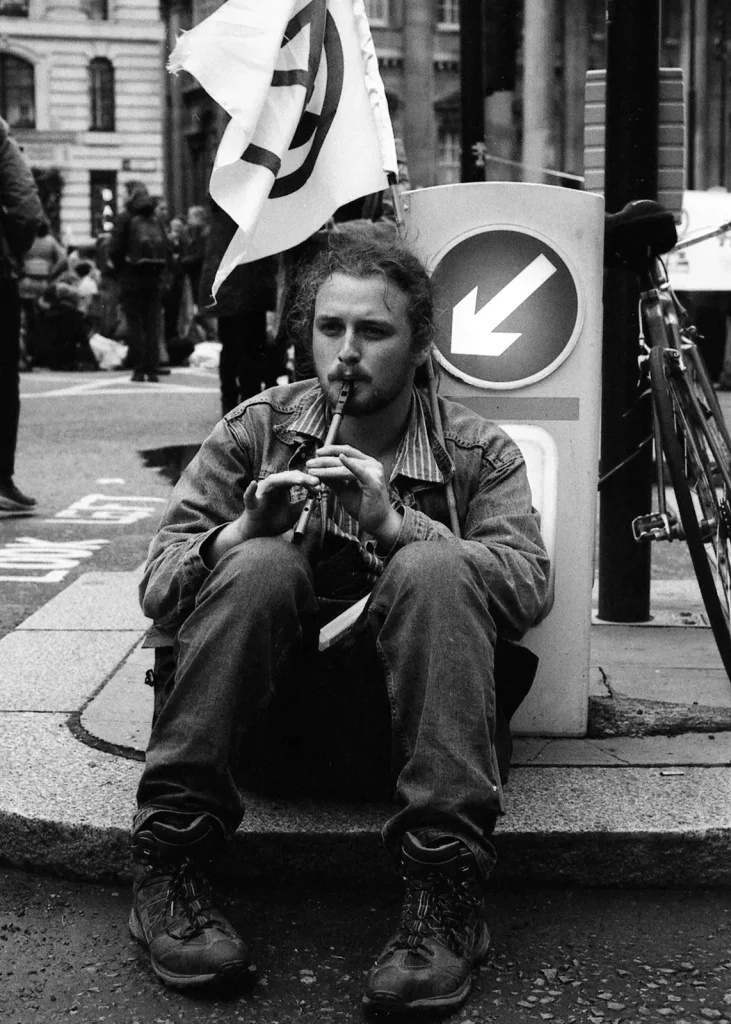
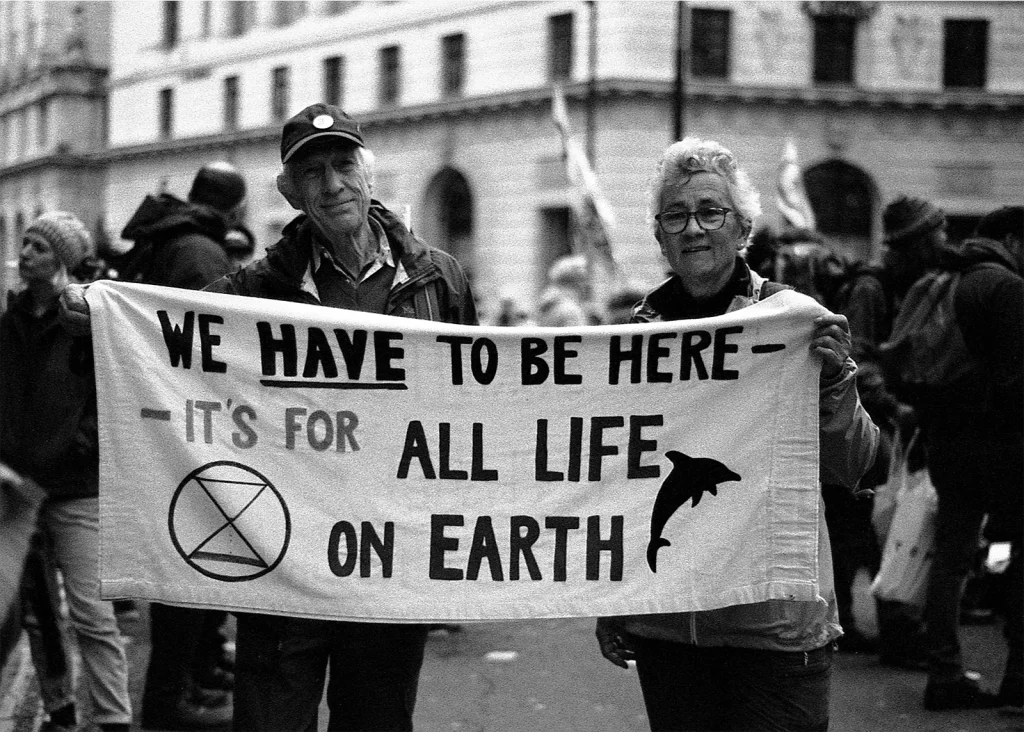
They feel posed and even slightly awkward. This is more like a photograph of a marathon runner with a tin-foil blanket draped over their shoulders and a medal hanging round their neck proudly presenting themselves to the press, than the frank image of a tired, sweating athlete sprinting towards the finish line that I was hoping for.
I realised that for me to achieve this level of candidness I would have to work harder to blend into my environment and spend less time with my camera quite obviously raised to my eye fine tuning my framing and exposure. I set my camera to f/8 in aperture priority mode (hoping the old photographer’s adage would ring true) and allowed the brains of the F80 and the latitude of the Tri-X to do the hard work whilst I set about finding another subject.
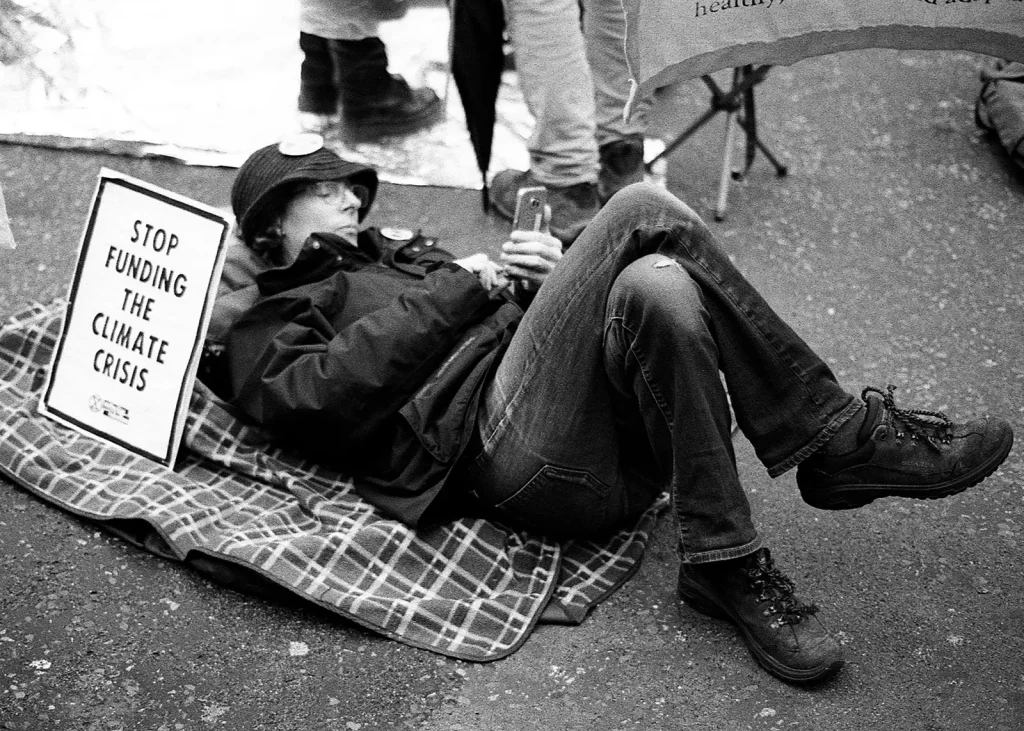
I was still quite cautious when approaching and interacting with people, I felt like I was deceiving people when photographing them by trying to capture an image before they realised that I was there and changed their behaviour. The lady above couldn’t have cared less however; she was so engrossed in whatever she was doing on her phone that she could have been anywhere in the world. If it wasn’t for the sign perched over her left shoulder, you would be forgiven for thinking that she was out having a picnic with friends. To me she looks like she is waiting for someone or something. I moved closer to the picket lines that were cordoned off for the next two images.
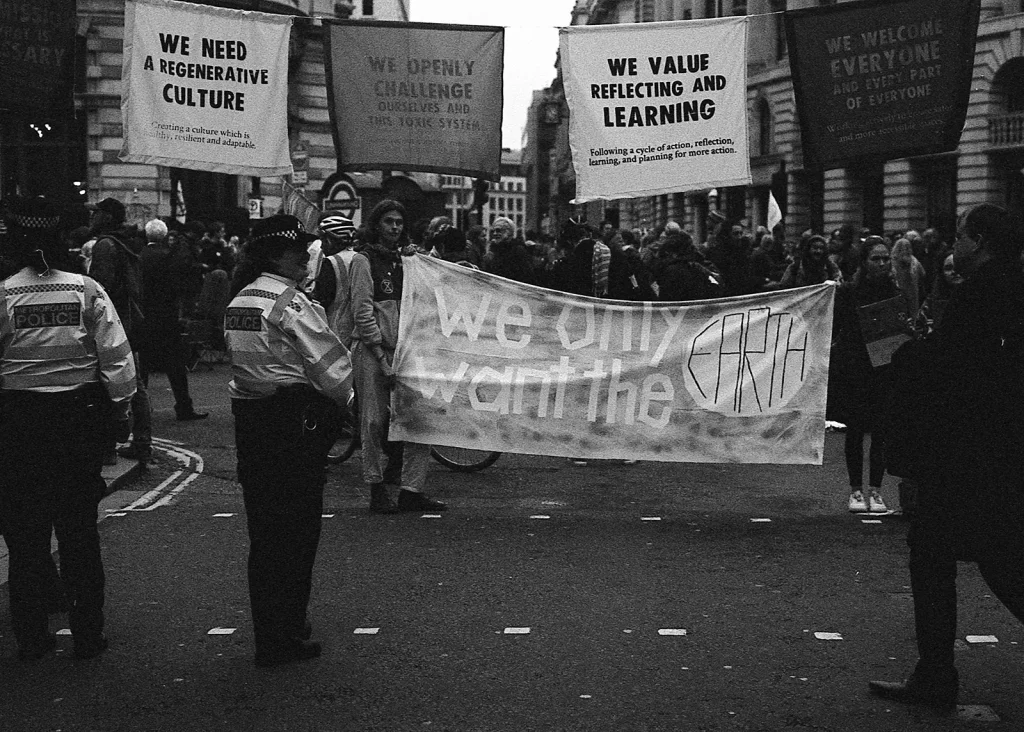
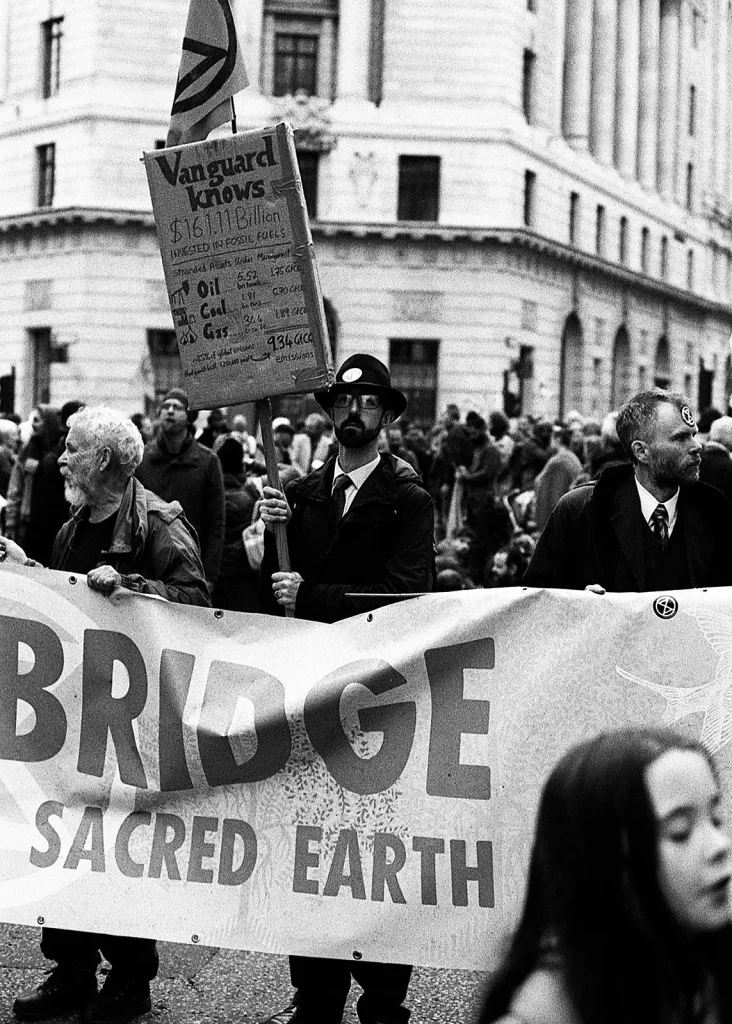
I was happier with the results that this yielded, in particular the last image of the man holding the placard proclaiming that “Vanguard knows.” He seems utterly alone in this photo as his fellow protestors look directly away from him and we see the softly out of focus face of a small child that runs past him without a second thought. We do not know who Vanguard are, nor seemingly does anybody else in the crowd and nor do they care. His loneliness is emphasised by his stare directly at me, a split second before the spark of recognition fires and he realises what I am doing and his guard goes back up.
I circled back towards the tube station and with a few shots left on my roll I decided I would stop in on their camp in Trafalgar Square to see if there was any activity there too. Before I got to the station I came across a man engaged in an enthusiastic discussion with two police officers, I took two photos of the scene and would like to share both with you below as I think that whilst each frame has its own merit, they are more interesting when viewed together.
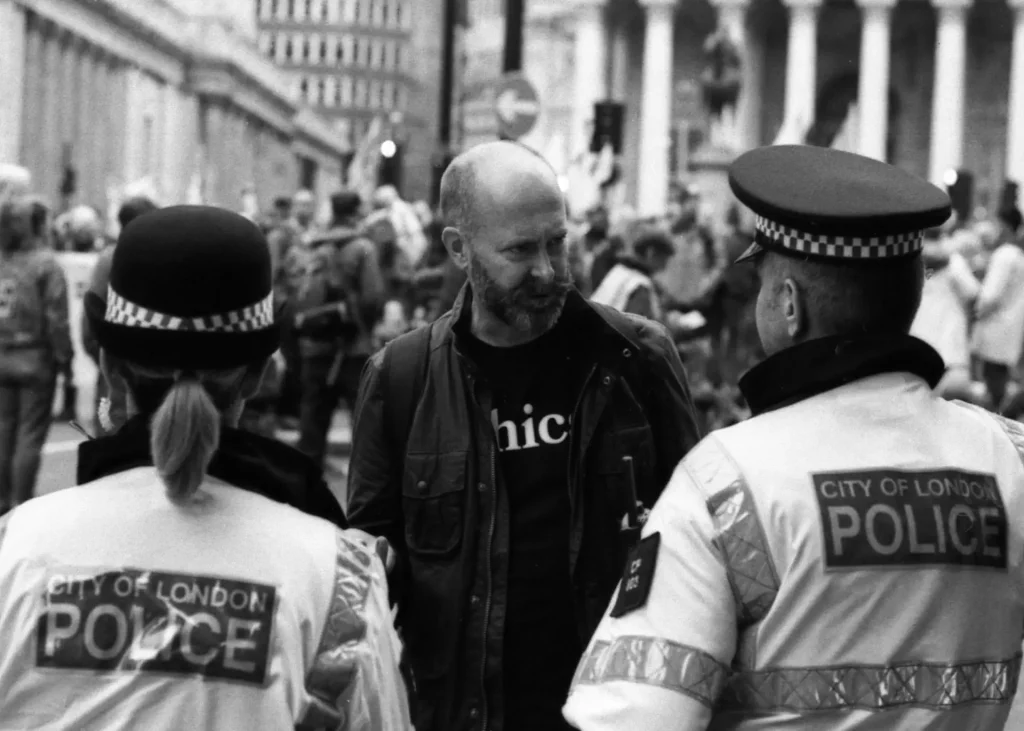
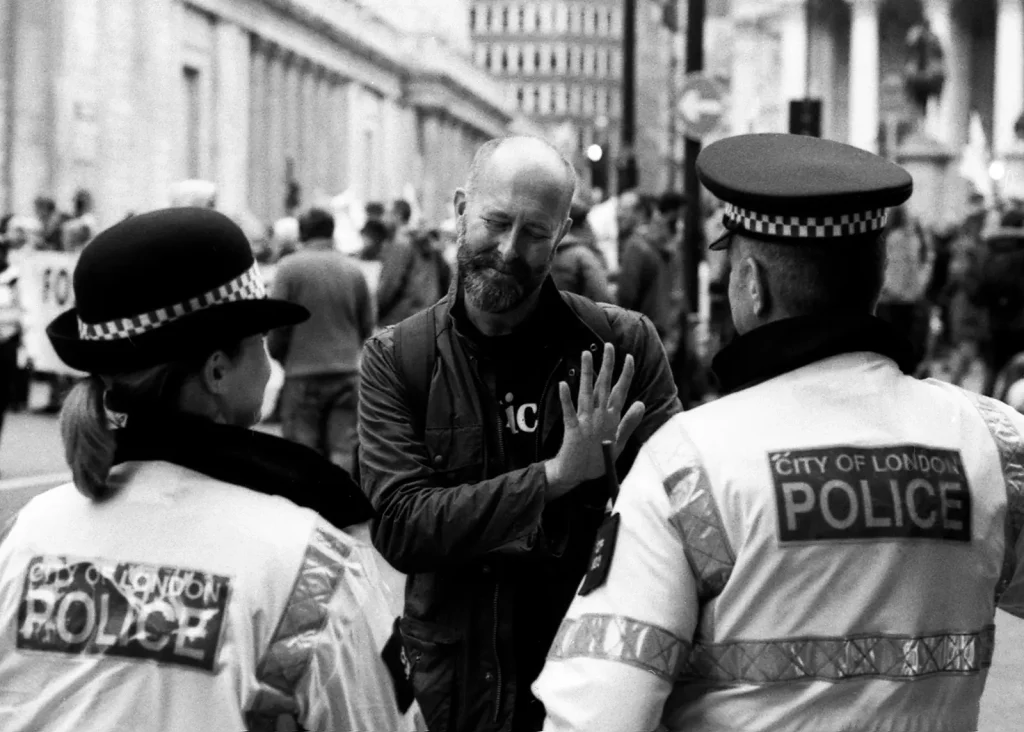
These photographs were taken seconds apart. The first is innocuous and shows a man engaging with the male police officer. The mood is calm and the female police officer on the left of the frame is apparently uninterested, she looks away from him, over his right shoulder. I do not know what was said between these people in that short space of time, but the dynamic of the second frame is vastly difference. The man has taken a step back and is gesticulating towards the male officer as if in a state of disbelief, the female officer has shifted and is now directing the entirety of her focus towards him. The man appears defensive and there is a clear sense of division in the image.
Seeing these two photographs side by side has reinforced in my mind the importance of body language; the accumulated effect of a series of seemingly insignificant shifts in posture, facial expression and movement can change the mood of an entire image.
The last two photographs were taken in and around Trafalgar Square.
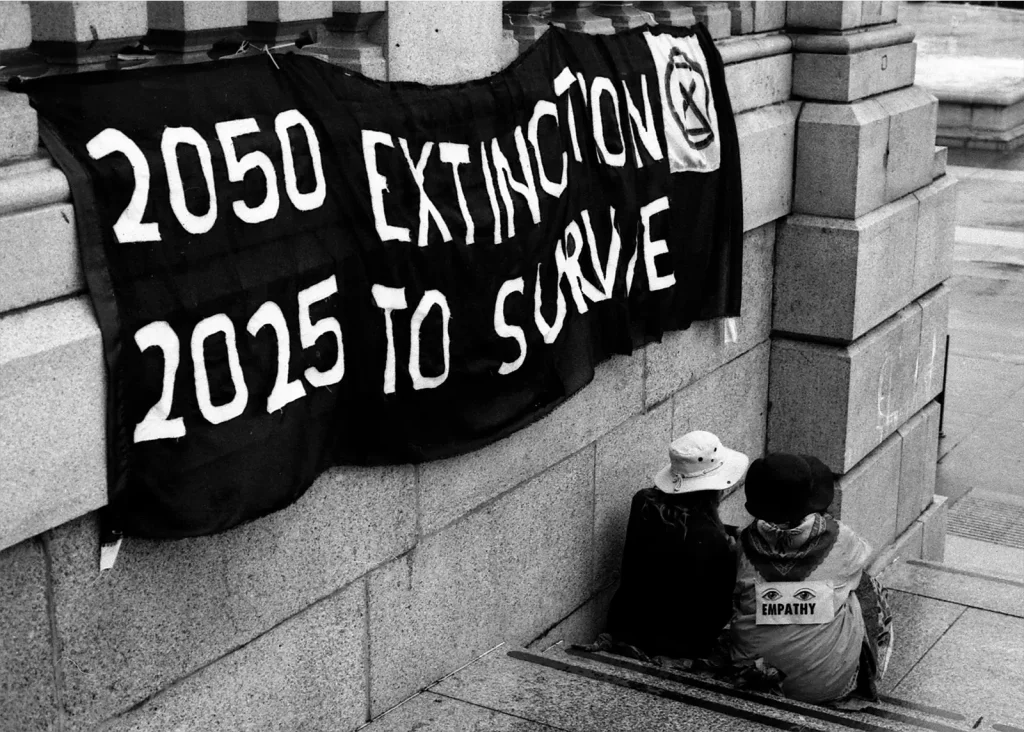
I was attracted to this scene by its geometric shapes, diagonal lines and pleasingly straightforward composition. What it may lack as a ‘street’ photograph, I think it makes up for in its simplicity. No matter where I look, my eyes are guided towards the two people that are sat together, taking a moment to simply enjoy each other’s company in what is a hectic environment. They lean towards one another to be closer; their emotions broadcast to the world by the sign on the back of the figure on the right’s coat.
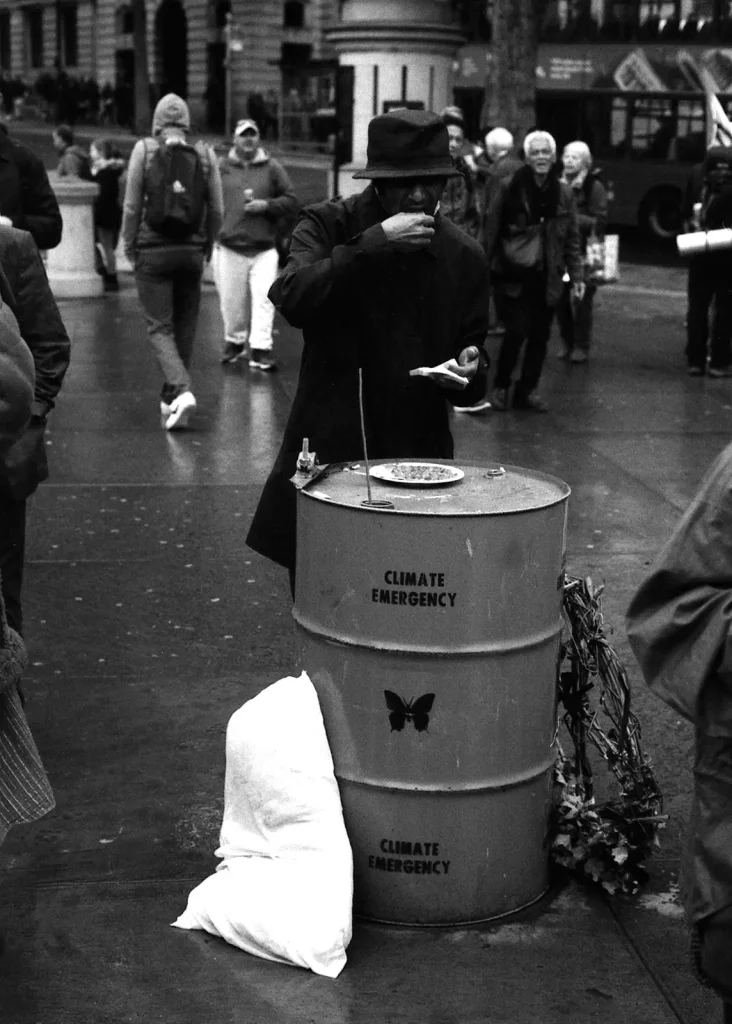
This final shot of a man resting his lunch on a recently repurposed oil drum is one of my favourites from the roll. He is elegant in the way that he carries himself and much like the recumbent women from Bank, is seemingly unaware of his surroundings. His incongruity with his environment and the hat which partially covers his face lends him a degree of mystery which I find curious and enticing.
Conclusion
From a technical perspective I am happy with the results. The grain is quite prominent as I expected shooting Tri-X at this speed, but in my mind contributes to the atmosphere of the images and does not distract the viewer from the subject. The high-contrast results are pleasing to my eye, and this is a film/speed/developer combination that I wouldn’t hesitate to use again under the right circumstances.
In terms of the of the images themselves, I feel like my personal journey as a photographer is progressing in the right direction. Sure, I have a long way to go before I will be truly confident sharing my work and having it stand shoulder to shoulder with some of the outstanding content that is published on this site and elsewhere, but to some degree I feel like I have achieved that which I set out to, and that alone is a source of immense satisfaction.
Share this post:
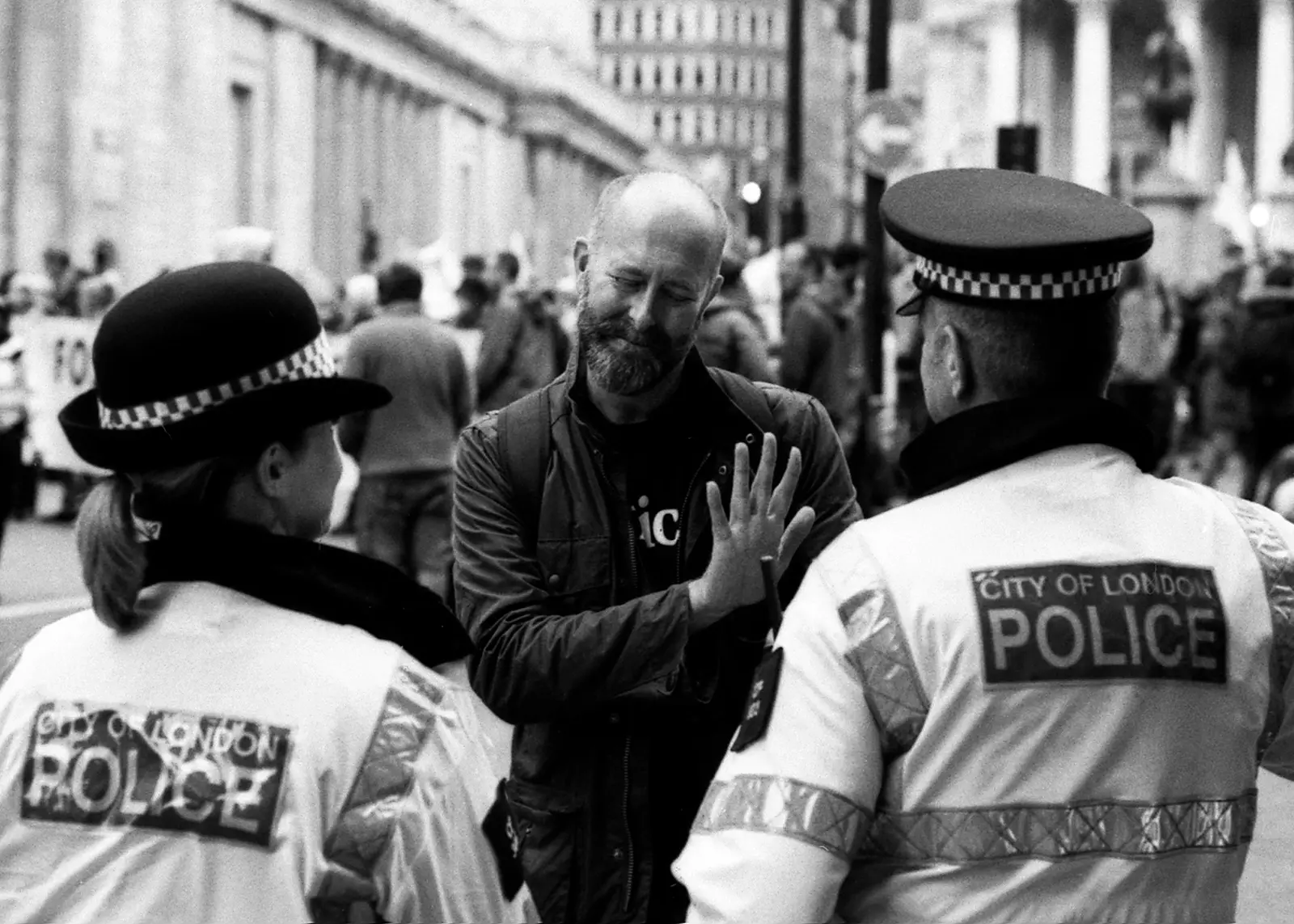








Comments
Simon on A Beginner’s Exploration of Documentary Photography – By Hugo Morgan
Comment posted: 13/12/2019
It's especially interesting to see these situations from another perspective; we must have passed by each other as I was around shooting these as well! Next time feel free to reach out on my Instagram if you like, I'm always happy to shoot with others! :)
I look forward to seeing your future work!
Callum Ross on A Beginner’s Exploration of Documentary Photography – By Hugo Morgan
Comment posted: 14/12/2019
Stephen McCullough on A Beginner’s Exploration of Documentary Photography – By Hugo Morgan
Comment posted: 14/12/2019
Thank you for taking the time to write and post this. It’s not always an easy thing to put your thoughts and art online.
I enjoyed reading about your ambition and process, and the open self critiquing that’s so important to growth.
As for the images I really love the two of the conversation. Printed and mounted side by side they are to my eye exactly what you were seeking to achieve.
Alexander Seidler on A Beginner’s Exploration of Documentary Photography – By Hugo Morgan
Comment posted: 19/12/2019
Charles Higham on A Beginner’s Exploration of Documentary Photography – By Hugo Morgan
Comment posted: 20/12/2019
Nick Ambrose on A Beginner’s Exploration of Documentary Photography – By Hugo Morgan
Comment posted: 02/08/2020
Christopher Blake on A Beginner’s Exploration of Documentary Photography – By Hugo Morgan
Comment posted: 25/02/2021
Really looking forward to bringing it all to fruition in an exhibition and photobook, which I've been extremely blessed to have sponsored by Canon Europe and Getty Images.
Keep up this great work. Looking forward to seeing more.
Peter on A Beginner’s Exploration of Documentary Photography – By Hugo Morgan
Comment posted: 09/04/2022
Which brings me to the photo of the lonely gent with the sign about Vanguard captioned ‘‘what is Vanguard? we don’t know, others are walking by oblivious as he stands alone”.
A simple Google tells me this: Vanguard is one of the world’s three largest investment funds in the fossil fuel industry. BlackRock, Vanguard and State Street together oversee assets worth more than China’s entire GDP and have continued to grow billion-dollar stakes in some of the most carbon-intensive companies since the Paris agreement. Vanguard have also routinely opposed motions at fossil fuel companies that would have forced directors to take more action on climate change.
Now the subject of this photo looks less like a crazy man in the genre of ‘lost souls steet photography’ and more like a document of a sane whistleblower in a society deliberately sleepwalking into major problems. While I very much appreciate anybody being reluctant to write about politics in a photography blog, in this one particular case it makes a difference to the image.